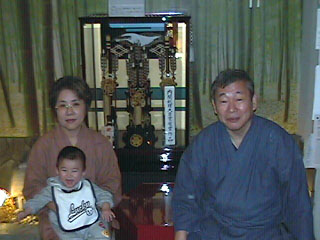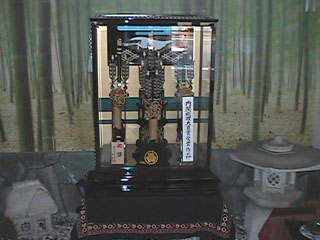
破魔弓
Origin of decorative arrows to ward off evil

(文:澤 功)
子供が生まれて初めて迎える新年を初正月といいます。この初正月に厄払いの縁起物として男の子には破魔弓を、女の子には羽子板を贈ってお祝いする風習が昔からあります。
これを家の中に、お正月らしく華やかに飾ることを「お正月節句飾り」といいます。
破魔弓は、魔を破り射ち払うといわれますが、弓矢の威力を信じて妖魔を退ける儀式として「鳴弦の儀」があります。
これは矢を使わず、弦を引いて弦打(つるうち)の音を立てて厄払いをする儀式です。
又、上棟式のさい、屋根の上に、破魔弓が飾られます。
これは、家屋の守護神に、これまでの工事が無事に進んだ感謝と、このさき竣工に至るまでの加護を祈願し、禍いなく、幸多いことを祈る祭事です。
さて、私共で飾っている破魔弓は、空穂飾りといいます。矢を入れる容器の空穂に7本の矢羽根があり、その両側に弓と2本の矢羽根で飾られています。
これは、私共の孫の諒の里方(母親の実家)から贈られました。里方では、諒は、初孫です。
破魔弓を、食堂の床の間に飾るため、空間の広さを測って里方に連絡をしました。ところが、買う段になって、こんなに大きな立派なものが届きました。床の間では、おさまらず入口の正面に飾っています。
諒が、すくすくと元気に育って行くことを願っています。
Origin of decorative arrows to ward off evil

Decorative arrows are traditionally a symbolic weapon against evil
and calamity in Japan. They are sold as special charms at Shinto shrines
to ensure good luck. During the New Year season, many Japanese visit shrines
to obtain an arrow to ensure good luck for the new year.
A decorative arrow is also commonly placed on the roofs of newly erected
buildings.
A long time ago, there was a ceremony to ward off evil spirits using the
sound of a warrior drawing his bow. This discriptiion was found in a book
written about 650 years ago called the Heike Story. The author is unknown
Sawanoya Innユs decorative arrows are also supposed to ward off evil. This
year we are celebrating the New Year with my grandson, Ryo. For the celebration
of Ryoユs first New Year seasonal festival, a set of the very best decorative
arrows was given to him from his maternal grandparents. They gave him a
set of seven arrows with white feathers in a beautifully lacquered container
called an メutsubo.モ Two bows and more arrows are included in the display.
By the way, the display is so large and elegant that it didnユt fit into
the alcove of our living room, where they are traditionally placed. So we
have displayed them in the lobby of Sawanoya Inn. And we wish that our grandson
Ryo will grow up to be a healthy boy. If you are in the Yanaka area, here
in the old section of Tokyo, please drop by and see the decorations.
──────────────────
Written by Isao Sawa and translated into English by Yoshihiro Kitagawa